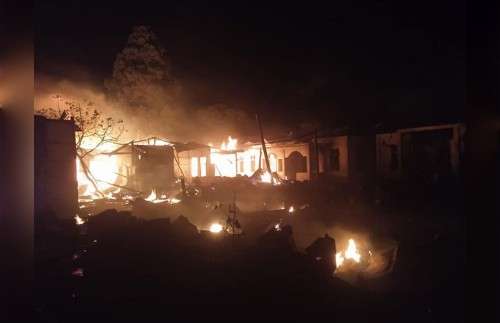By Debdutta Ghosh
It is undoubted that cyberspace is a place where crime is growing fast. What makes the situation more alarming is that geographic boundaries are do not exist and a hacker can easily steal away valuable information from a remote location. While a computer or a smartphone connected to the internet offers a wide range of benefits for users, it can also easily turn out to be a conduit for illegal activities – with the perpetuators of a crime remaining in relative obscurity.

In A Declaration On The Floor Of The Parliament In December Of 2019, The Ministry Of Electronics And Information Technology Reported A 77 Per Cent Growth In Just Two Years In The Number Of Cybercrime Cases Registered In The Country. In 2017, On An Average 21,796 Cyber Crime Cases Were Registered Under The Information Technology Act, 2000, As Well As Other Sections Of The Indian Penal Code (IPC) Every Day Over The Last Two Years Across The Country, Shows Data From The National Crime Records Bureau (NCRB). The Number Was At 11,592 In 2015 And 12,317 In 2016. This Shows The Fearful Plight Of Cybercrimes In India
In recent years, there has been significant growth in the spread and penetration of the internet – especially because of the low rates of internet connectivity and affordable smartphones. While this growth has boosted some industries like online retailing, it has also opened a pandora’s box of cybercrime.
India is projected to have more than 730 million users by 2020 which will make it the third largest market of internet users after the United States and China. Over the last few years, internet adoption in the country has grown at almost 44 per cent annually.
However, with this phenomenal spread of the internet, there has also been a huge rise in reported incidents of cybercrime.
According to a report by the Indian Computer Emergency Response Team (CERT-In), a Central government agency created in 2004 to respond to incidents of emergency in cyberspace, there were more than 8.5 lakh cyber security incidents between 2004 and October 2019. The incidents included phishing, spoofing, network scanning and probing, data breaches, disruption of services, virus infection, code manipulation and website hacking, the agency said.
Given below is a comparison of the cyber security incidents over the last four years alone:
| Year | Number of cybercrimes reported |
| 2016 | 50,362 |
| 2017 | 53,117 |
| 2018 | 2,08,456 |
| Oct. 2019 | 3,13,649 |
The growth in the incidents of cybercrime in India can easily be gauged from these figures.
Two recent incidents in February this year alone illustrate the depth and breadth of cybercrimes in the country.
21-year old Dipu Singh was arrested by the Narcotics Control Bureau (NCB) and was described as the first so called ‘darknet’ narcotics operative of India. This young man who is well educated and the son of a retired office of the Indian army used the internet to sell and ship hundreds of psychotropic drug parcels top foreign countries posing them to be sex stimulation medicines. Singh made use of the deep hidden internet platform called ‘darknet’ used for advertisement and sale of narcotics, pornographic content and other illegal activities. The trick is the use of the secret alleys of the onion router (ToR) which allows such criminals to avoid surveillance of law enforcement authorities. Further, since there is end-to-end encryption, it is nearly impossible to break into activities within the ‘darknet’ the outside by law enforcement agencies and to monitor illegal activities there.

In another incident in February this year, credit and debit card details of almost half a million Indians were advertised for selling on a darknet website called Joker’s Stash. The data included private and sensitive information about the cards such as the 12 digit cards numbers, their expiration dates, CVV/CVC codes, names of the cardholders and email addresses in some cases. Cybersecurity experts say that this information about a credit or a debit card is enough o carry out transactions online without need for and further authentication of identify of the card holder.
The CERT-In data also showed that the cybercrimes ort attacks that took place in India had their origin in a number of countries such as Algeria, Brazil, China, France, the Netherlands, North Korea, Pakistan, Russia, Serbia, South Korea, Taiwan, Thailand, Tunisia, the USA and Vietnam, in addition to India – off course. This was determined by analyzing the analysis of the logs of such incidents which revealed the Internet Protocol (IP) addresses of the computers of the hackers.
In a declaration on the floor of the Parliament in December of 2019, the Ministry of Electronics and Information Technology reported a 77 per cent growth in just two years in the number of cybercrime cases registered in the country. in 2017, on an average 21,796 cyber crime cases were registered under the Information Technology Act, 2000, as well as other sections of the Indian Penal Code (IPC) every day over the last two years across the country, shows data from the National Crime Records Bureau (NCRB). The number was at 11,592 in 2015 and 12,317 in 2016. This shows the fearful plight of cybercrimes in India.
Budget analysis reveals that funding in this field has been noticeably declining over the past four fiscals. Official data shows that the budgetary estimate (BE) of Rs70 crore for CERT-in in 2016-17 was reduced to Rs53.61 crore in the revised estimate (RE) and the actual spending was Rs41.27 crore.
In 2017-18, the BE and RE were Rs40.28 crore and Rs26.48 crore, with the actual spending being Rs22.92 crore. The respective figures in 2018-19 were Rs40 crore, Rs31.83 crore and Rs29.89 crore. For the 2019-20 fiscal, the BE and RE are Rs49.75 crore and Rs42 crore. While there were no budgetary provisions for special cyber security projects in 2016-17, the BE of Rs100 crore in 2017-18 was brought down to Rs60 crore in the RE, out of which Rs55.69 crore could be utilised. The year 2018-19 was a bit better with the BE of Rs110 crore remaining unchanged in the RE and finally Rs107.48 crore being spent. The BE of Rs586.05 crore for 2019-2020 has been drastically curtailed to Rs120 crore in the RE.
As part of the special cyber security projects, the Union government is setting up the National Cyber Coordination Centre (NCCC) to generate near real-time macroscopic views of the cyber security threats. The centre will scan the cyberspace at meta data level and generate real-time situational awareness. Being implemented by CERT-in, it will be a multi-stakeholder body and provide a structured system and facilitate coordination among different agencies.
While phase-I has been operationalised, the second phase is scheduled to be functional this year for analysis of meta data from 15 remote sites.
Another area where the government has been found wanting is telecom network security. A proposal to establish a Telecommunication Security Testing Laboratory for security testing of various network elements was approved in 2015, but there were no bidders for repeated tenders.
In its latest report tabled in the Lok Sabha, the Standing Committee on IT stated that the lab has assumed significance as the Centre has mandated that it will be compulsory for the telecom equipment to be tested and certified prior to import, use or sale into the country. “More so, as admitted by the Secretary, DoT, security equipment testing in India is not of world standard,” the report added.
Report Warns,Climate Change Set to Cut Average Income by 19%
Timor-Leste Seeks Economic Lifeline as Oil Wealth Dwindles
South Africa Prepares to End Lion Hunting in Captivity
UN Secretary-General Meets with Working Group on Discrimination Against Women and Girls
On Both US Coasts,Pro Palestinian Encampment Protesters Hold Ground
Philippine Police Arrest 3 Suspects Over On-Air Killing of Broadcaster
In Tibet, Parents Plead for Children to Help Collect Caterpillar Fungus
Vietnamese Monk Seeks Justice for Brother Who Died after Police Interrogation
Subscribe Our You Tube Channel
Fighting Fake News
Fighting Lies














